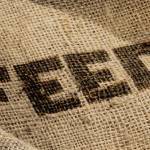Does a High-Starch Diet Make Horses More Reactive?

Horses on a training or performance schedule are often fed large meals of grain to provide the energy for the exercise they are asked to do. Diets rich in starch-laden grain are quite different from the horse’s natural eating pattern that is based almost completely on forage. Dietary grain produces a greater glycemic response in horses than forage, and some riders and trainers report that there is also an increase in reactive behavior when horses eat grain.
At the European Workshop on Equine Nutrition, British researchers reported on a study* of the behavioral and physiological responses of horses fed either high-starch (HS) or high-fiber (HF) diets. In the study, eight mature horses (mean age 13) of several breeds and work levels were divided into two groups, with two mares and two geldings in each group. Horses in the first group were given a diet of hay and a high-starch compound mix for 28 days and those in the second group received haylage plus alfalfa (lucerne). For the second 28-day period, researchers switched the groups and diets. All horses participated in light work throughout the study. The researchers included an adaptation period in the first 28-day study session.
On days 0, 7, 14, 21 and 28 of each study period, behavioral and physiological measurements were recorded as the horses were handled and reacted to a novel object. The researchers averaged the results over the five days of testing to achieve a total effect of diet.
Compared to horses on the high-fiber diet, those on the high-starch diet showed higher average and maximum heart rates during handling. Horses on the high-starch diet also showed more interruptions in eating and higher heart rates than those on the high-fiber diet when a novel object was presented during a meal. The researchers explained that higher heart rates can indicate fear or excitement in horses. While the horses in this study did not show excessive behavioral reactions to novel objects, this could be related to the fact that they were mature and were handled by competent, experienced riders. Younger, less well-trained horses handled by people with less experience might have shown stronger behavioral results.
Kathleen Crandell, an equine nutritionist with Kentucky Equine Research, explains that most horses consume a high-fiber diet if they are using forage as the basis with small amounts of concentrates added to meet an exercising horse’s requirement for energy. It is not just the amount of starch in the feed, but the quantity of feed that may have an effect on behavior. Yet, not all horses are influenced by the amount of starch in the diet and in some types of competitions, heightened awareness is helpful to the performance. Some horses are high-strung no matter what you feed them, but if there is a concern with an individual, it is worth trying a low-starch diet, according to Crandell.
Kentucky Equine Research completed a study using heart rate variability (HRV) as a method to gauge stress and behavior in horses fed nonstructural carbohydrates. HRV records the fluctuations between successive heartbeats, thereby measuring the function of the autonomic nervous system. HRV has been successfully used to study stress and behavior in humans and other species of livestock. KER’s study examined the effects of NSC levels on equine stress and behavior using HRV indices.
Two feeds with different NSC levels (20.36% or 51.41%) were used in a four-week switchback study using four mature Thoroughbred geldings. The feeds were fed at levels calculated to supply a similar intake of digestible energy (DE), and there were no differences in weight change in the horses when fed either diet. It was hypothesized that HRV indices would be higher with low NSC intake, indicating increased parasympathetic tone and a calmer demeanor. HRV data were collected using a Polar heart rate monitor and an iOS-based Heart Rate Variability Logger (Marco Altini), and analyzed using paired t-tests.
There were no significant differences between low- or high-NSC diets for the mean of RR-intervals (AVNN), standard deviation of RR-intervals (SDNN), square root of the mean squared difference of successive RR intervals (rMSSD), low-frequency power (LF), high-frequency power (HF), low-to-high frequency power ratio (LFHF), and average heart rate (AvgHR). The proportion of pairs of RR intervals that differed by more than 50 ms (pNN50) were significantly higher (P < 0.05) for the low-NSC diet compared to the high-NSC diet. A higher pNN50 is indicative of increased parasympathetic nervous system activity that has been associated with decreased stress and a more relaxed state. This study suggests that NSC content of feed may affect behavior in horses.
*Bulmer, L., S. McBride, K. Williams, and J. Murray. 2015. The effects of a high-starch or high-fibre diet on equine reactivity and handling behaviour. Applied Animal Science Behavior 165:95-102.








